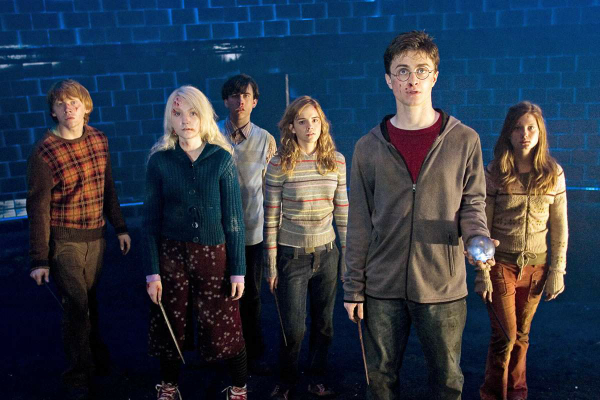Movie review by Greg Carlson
Despite being an undeniable financial success at the box office, the Harry Potter film series has always been faced with the impossible task of balancing faithfulness to the source material with good filmmaking. Typically, the producers err on the side of the former, making the film franchise slow going for audience members who do not keep up with the books. It is surely a good thing that at 138 minutes, “Harry Potter and the Order of the Phoenix” is officially the shortest of the five Potter films, running just a few ticks behind the best of the movies, the Alfonso Cuaron-helmed “Harry Potter and the Prisoner of Azkaban.”
Director David Yates, who will be returning for the next Potter movie, and screenwriter Michael Goldenberg, who replaces Steve Kloves for the first time in the series, have their hands full paring down J.K. Rowling’s massive 850-plus page tome. Predictably, the result is a somewhat bland streamlining process that compresses action, eliminates subplots and explanations, and most unfortunately, short-shrifts all sorts of characters. Hermione and Ron, Harry’s true blue pals, must compete with the usual superstar lineup of British acting royalty and the fresh-faced newcomers chosen to play Harry’s classmates at Hogwarts.
Audiences will likely be divided over the film’s mostly dismal tone, which now marks Harry as a brooding young Hamlet who carries the weight of the world on his fragile psyche. Following an opening set-piece attack by a pair of ghastly Dementors, Harry defends himself before the Ministry of Magic for casting a spell in the presence of a Muggle. Narrowly avoiding expulsion, he returns to Hogwarts only to find that Ministry representative Dolores Umbridge (a perfectly cast Imelda Staunton) has joined the staff. Umbridge wastes no time asserting her strict brand of discipline and control, forcing Potter to go underground with a group of stalwarts branding themselves Dumbledore’s Army.
When he is not avoiding Umbridge or practicing spells, Harry finds himself in the grip of cold-sweat nightmares revolving around the return of Lord Voldemort (Ralph Fiennes), who appears to be drawing closer by the day. Both Sirius Black (Gary Oldman), who shares some personal history with Harry, and Professor Snape (Alan Rickman, in the movie’s standout performance), who unwillingly reveals painful memories to Harry, are on hand to offer the young wizard some protection. The film’s climactic battle is gripping and satisfying.
Typical of the series, the production values are extremely handsome. Computer generated effects continue to develop by leaps and bounds, and a comparison to the early entries shows a remarkable advance. Even so, some of the CG imagery, particularly Hagrid’s giant kin Grawp, lacks the same sense of wonder conveyed by actual physical objects. With the release of Rowling’s final novel neatly coinciding with the current movie, Potter mania will remain as strong as ever. As of now, the last Potter movie is scheduled for release in 2010, which puts all three of the principal performers in their twenties by the likely release date. So far, the transition from childhood to adulthood has been adroitly handled in the films, and it will be interesting to see how the last two stories make the leap to the screen.
